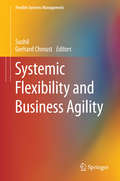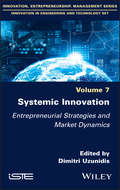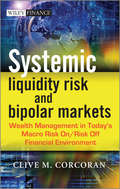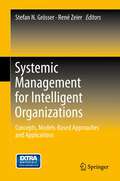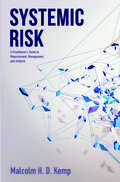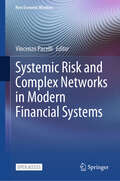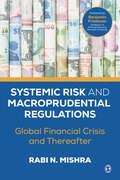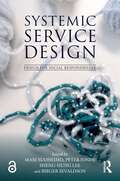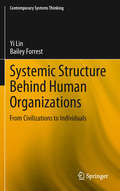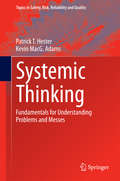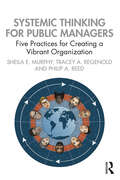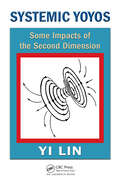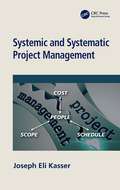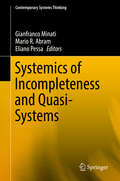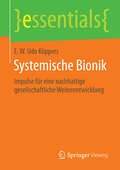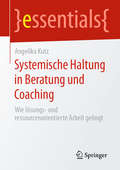- Table View
- List View
Systemic Flexibility and Business Agility
by Sushil Gerhard ChroustThis book provides a conceptual framework for systemic flexibility and business agility, drawing on a basis of research/case applications in various types of flexibility and agility in business. The selected papers address a variety of issues concerning the theme of systemic flexibility and business agility and are organized into following five parts: (i) Systemic and Strategic Flexibility; (ii) Information and Business Agility; (iii) Flexibility, Innovation and Business Excellence; (iv) Flexibility in Value and Supply Chains; and(v) Financial Flexibility and Mergers & Acquisitions. Flexibility and agility in business are emerging as key dimensions of business excellence that encompass the requirements of both choice and speed. The two concepts, flexibility and agility, have been used in multiple ways and often interchangeably, both in literature and in practice. The growing need for flexibility/agility in business can be seen from reactive as well as proactive perspectives. A business enterprise is expected to possess reactive flexibility/ agility (as adaptability and responsiveness) in order to cope with the changing and uncertain business environment. It may also endeavor to intentionally generate flexibility/agility as a strategic change in a variety of ways, such as leadership change, reengineering, innovation in products and processes, use of information and communication technology, and learning orientation.
Systemic Innovation: Entrepreneurial Strategies and Market Dynamics (New Horizons In The Economics Of Innovation Ser.)
by Dimitri UzunidisINNOVATION IN ENGINEERING AND TECHNOLOGY SET Coordinated by Dimitri UzunidisSystemic innovation is based on business networks and new business models in a global economy integrated by flows of knowledge, capital, and goods. The authors of this book consider the theory that innovations act as systems based on multi-actor interactions. Innovation is contextualized to demonstrate in what capacity a company or an entrepreneur can innovate.The book details the management of scientific, technical and cognitive resources, the relationships between R&D partners, the creativity and the rules that allow a market and a company to innovate.This contextualization, associated with entrepreneurial strategy, leads to systemic innovation. This book analyzes some key sectors of the economy that are knowledge-intensive and rapidly changing: transport and communications, defense, information technology, artificial intelligence, and the environment.
Systemic Liquidity Risk and Bipolar Markets
by Clive CorcoranThe dramatic and well chronicled crisis of 2007/8 marked a watershed moment for all stakeholders in global capital markets. In the aftermath, financial markets have become even more tightly coupled as correlations in returns across multiple asset classes have been at historically elevated levels. Investors and fund managers are, to a much larger degree than previously and often much more than they realize, subject to the risk of severe wealth destruction. The ultimate hazard, which is not adequately characterized by the widely touted notion of tail risk, is the systemic risk which arises when liquidity in markets completely evaporates. Not only did this happen in the second half of 2008, but it has been repeated episodically since then - most notably in May 2010, in an incident known as the Flash Crash, and in the fall of 2011 when correlations were at historically elevated levels. Conventional asset allocation tools and techniques have failed to keep apace with the changing financial landscape which has emerged since 2008. In addition to the preponderance of algorithmic trading and the associated changes in the liquidity characteristics of financial markets, a new paradigm of risk on/risk off asset allocation has emerged. Risk on/risk off is a widely adopted style of trading and macro allocation strategy where positions are taken in several closely aligned asset classes depending on the prevailing sentiment or appetite for risk. The consequences of the day to day (and intraday) switching between either a risk on or risk off tactical strategies poses significant new challenges to investors who are still making investment decisions with outmoded notions from traditional asset allocation theory. How can one cushion the impact of systemically threatening events when the ability to exit financial instruments becomes almost non existent? How can one trust the integrity of financial models and orthodox macro financial theory which have become increasingly discredited? Can central bankers be relied upon to become the counter-parties of last resort and provide a safety net under the financial system? These vital questions, and many others, need to be addressed by everyone who has a stake in modern financial markets, and they are addressed in Systemic Liquidity Risk and Bipolar Markets. Proper functioning markets require fractiousness or divided opinion, and this needs to be lubricated by communications from central bankers, economic forecasters, corporate executives and so on. As long as such messages and market conditions remain ambiguous, providing asymmetric information to different market players, then the conditions are present to enable systemic liquidity to be preserved. Seen in this context the prevailing paradigm of bipolar risk on/risk off asset allocations is both a prerequisite to liquid markets, and also paradoxically, when one side of the polarity becomes too extreme, a major source of systemic instability. Should such polarities become critically unbalanced, and should the signals received by market players become symmetrically disadvantageous as they were in the fall of 2008, then an even more substantial systemic liquidity crisis than that seen in those troubled times is a dangerous possibility. Apart from the practical risk management tools and tactics that are recommended in Systemic Liquidity Risk and Bipolar Markets, there is a provocative and cogent narrative to provide anxious and perplexed investors with a coherent explanation of the post GFC financial environment, and which should assist them in navigating the choppy waters ahead.
Systemic Management for Intelligent Organizations: Concepts, Models-Based Approaches and Applications
by Stefan N. Grösser René ZeierThe last two decades increasingly have challenged the field of management by confronting it with rapidly growing levels of dynamism, inter-connectedness, and complexity. Systems-based management approaches, their promise already proven, offer great potentials for influencing and coping with this development. This collection of essays offers ideas and exemplary case studies from experts in systemic management, organiza-tional cybernetics, and system dynamics for meeting the challenges in so-cio-economic systems. This book was compiled to honor the academic achievement of Markus Schwaninger, a leading protagonist in developing the field of systemic management and organizational cybernetics. His stature in the field is demonstrated in the forewords by Raul Espejo and John Sterman. The efforts of 18 researchers and practitioners, all closely related to Markus Schwaninger, offer conceptual and empirical approaches that will allow managers and advanced students of the management profession to analyze, understand, and design intelligent organizations. The book weaves its content from both theory and practice and offers hints for improving a variety of organizations, both private and public, profit and non-profit, and large and small.
Systemic Principles of Applied Economic Philosophies I: Producers, Consumers, and the Firm (Translational Systems Sciences #38)
by Jeffrey Yi-Lin ForrestThe objective of this book is to answer the calls from front-line managers, entrepreneurs, and scholarly researchers to reconstruct the theories of economics and business. Their request is for new theories to be more relevant to real life than the now-prevalent ones. To provide that answer, the book proposes to develop elementary postulates at the level of the four natural endowments of a business firm or an individual: self-awareness, imagination, conscience, and free will. Then, conclusions based on these postulates can be established through logical reasoning. On this realistic footing, the book employs the concepts, methodology, and logical reasoning of systems science to answer a full list of theoretically and practically important questions. Those queries involve such topics as rationality, the meanings of optima and choices of optimization methods, the relationship between micro- and macro-phenomena, consumption preferences, and utility representations. The target audience of the book includes graduate students and scholarly researchers, particularly those who look for opportunities to develop new territories in the world of economic and business knowledge. The book also aims at front-line decision-making managers and entrepreneurs who seek sounder theories than the commonly available ones on which to base their critical decisions. By competently employing the systemic intuition–yoyo model, graduate students, scholarly researchers, decision-making managers, and entrepreneurs can attain new conclusions. In addition, they will gain insightful understanding of market signals without unnecessarily expending other resources of limited availability.
Systemic Principles of Applied Economic Philosophies II: Value, Decision, and Large-Scale Business Forces (Translational Systems Sciences #39)
by Jeffrey Yi-Lin ForrestThe objective of this book, the second volume of this monograph series, is to respond to the calls from front-line managers, entrepreneurs, and scholarly researchers to reconstruct the theories of economics and business so that the new theories will be more relevant to real life than the prevalent ones. Differing from what is presented in the first volume, this second volume emphasizes the development of systemic principles underlying a whole series of empirical discoveries and theoretical conclusions in more applied business studies. By employing the concepts, methodology, and logical reasoning of systems science, this volume addresses important issues about value creation and capture, managerial decision making in the modern business world, and the management of large-scale business forces.The book particularly targets graduate students and scholarly researchers who are looking for opportunities to develop new territory in the world of applied economic and business knowledge. In addition, it aims at front-line decision-making managers and entrepreneurs who want sounder theories and more reliable methods than the commonly available ones on which to base their critical decisions. By masterfully employing the concepts, methodology, and logical reasoning of systems science, readers can expect to become better able to discover the previously unfamiliar essence of business practices and insightful opportunities for profit.
Systemic Risk
by Malcolm H.D. KempSystemic Risk provides readers with a wide-ranging practical guide to systemic risk in the financial system. It challenges the notion that systemic risk is exclusively about interconnectivities within the financial system, showing that past systemic risk crises have often involved a broader range of vulnerabilities.It describes how regulators and governments are seeking to manage systemic risk, and how their concerns are driving change in regulatory and business environments across the financial sector. It sets out how firms and practitioners can effectively respond to these changes (covering topics such as data needs, quantification of risk exposures, management disciplines and skillset requirements etc.). It highlights the sources and characteristics of systemic risk and the concentrations of exposures to this risk. It also links systemic risk with other risk disciplines including exploring how systemic risk ties in with liquidity risk and credit risk and how it interacts with central clearing, collateralisation and pricing of derivatives.
Systemic Risk and Complex Networks in Modern Financial Systems (New Economic Windows)
by Vincenzo PacelliThis open access book is a groundbreaking exploration of systemic risk in modern financial systems. Through its theoretical and empirical investigations, it reveals the multidimensionality of systemic risk, the transmission channels of crises, and the interlinkages between physical, transition, and financial risks. It introduces cutting-edge methodologies, including prediction and optimization models based on complex networks, multilayer networks and eXplainable Artificial Intelligence (XAI) approaches, to forecast and measure systemic risk and financial crisis. It provides insight for academics, practitioners, policy and supervisory authorities, and bankers and financial market operators on understanding the links that determine the propagation of financial crises and the emergence of systemic risks. This book is essential for those wishing to better understand systemic risk and its implications.
Systemic Risk and Macroprudential Regulations: Global Financial Crisis and Thereafter
by Rabi N. MishraThe Global Financial Crisis is undoubtedly the most severe financial crisis the world witnessed since the Great Depression of 1929. The crisis has been analysed by a number of experts offering distinct narratives and counter-narratives. Systemic Risk and Macroprudential Regulations examines causes and consequences of the global financial crisis and proposes a regulatory reforms policy—macroprudential regulations. The book emphasizes ‘systemic risk’ as the new-found villain of the financial space and narrates how such risk can be addressed through macroprudential tools. It, thus, offers a possible solution to avoid financial crises in future and facilitates building a safer financial system globally. The book also examines major crisis management frameworks, stress testing, relevant regulatory and supervisory development, and early warning mechanism with detailed cross-country analysis.
Systemic Risk and the Future of Insurance Regulation (Lloyd's Insurance Law Library)
by Miriam Goldby Andromachi GeorgosouliThis book examines policy developments that have been occurring in the field of financial regulation and their implications for the insurance industry and markets. With UK and US contributors from academia and legal practice, this book will be essential reading for policy-makers, insurance regulators, insurance and legal professionals as well as students and academics researching and studying insurance law.
Systemic Risk in the Financial Sector: Ten Years After the Great Crash
by Emilios Avgouleas Douglas W. Arner Danny Busch Steven L. SchwarczThe 2008 global financial crisis brought the world's economy closer to collapse than ever before. Has enough been done to prevent another crisis?
Systemic Risk in the Financial Sector: Ten Years After the Great Crash
by Douglas W. Arner; Emilios Avgouleas; Danny Busch; Steven L. SchwarczIn late 2008, the world's financial system was teetering on the brink of systemic collapse. While the impacts of the global financial crisis would be felt immediately, at every level of the economy, it would also send years-long aftershocks through investment, banking and regulatory circles worldwide. More than a decade after the worst year of the global financial crisis, what has been learned from its harsh lessons? Are governments and regulators more prepared for another financial system failure that would significantly affect the real economy? What may be the potential triggers for such a collapse to occur in the future? Systemic Risk in the Financial Sector: Ten Years after the Great Crash draws on some of the world's leading experts on financial stability and regulation to examine and critique the progress made since 2008 in addressing systemic risk. The book covers topics such as central banks and macroprudential policies; fintech; regulators' perspectives from the United States and the European Union; the logistical and incentive challenges that impede standardization and collection; clearing houses and systemic risk; optimal resolution and bail-in tools; and bank leverage, welfare and regulation. Drawing on experts across disciplines — including Howell Jackson, John Geanakoplos, Charles Goodhart, Anat Admati, Roberta Romano and Martin Hellwig — Systemic Risk in the Financial Sector is the definitive guide to understanding the global financial crisis, the safeguards being put into place to try to avoid similar crises in the future, and the limitations of those safeguards.
Systemic Risks and the Macroeconomy
by Gianni De Nicolò Marcella LucchettaA report from the International Monetary Fund.
Systemic Service Design (Design for Social Responsibility)
by Peter Jones Mari Suoheimo Sheng-Hung Lee Birger SevaldsonSystemic Service Design provides a comprehensive overview of how systems theories can be integrated into service design to address complex social-economic-technological challenges. Across 14 chapters split into two sections, the book connects theoretical backgrounds and practical worldwide case studies to explore various approaches to systems thinking.The field of service design has evolved significantly in recent years, from focusing on touchpoints and user interactions to being seen as a driver for organizational transformation and increasingly, a key component in transdisciplinary spaces involving complex systems. However, while service design has grown over the past few decades, it has also recognized its limitations in addressing complex societal problems. For example, the book highlights how a lack of holistic understanding of the systems in place can lead to service failure, which ultimately results in societal issues relating to unemployment, healthcare, and public transportation. As such, this book offers theoretical and practical resources specifically tailored to service designers in order to equip them with the ability to develop solutions that are appropriate in scope, depth, and feasibility to address these complex issues. Contributing authors draw upon and integrate theories from related disciplinary fields to extend the contextualization of service design within complex systems, providing readers with more scientific frames of reference. The book also draws upon case studies from South and North America, Europe, Asia, and Australia, to offer readers wide-ranging perspectives and real-life examples to further their understanding of systemic service design and demonstrate how to integrate it successfully.The book delivers theoretical and practical knowledge for students and designers in the fields of service design, design for policy, social design, and additionally for managers, public and private sector planners, engineers, and politicians.The Open Access version of this book, available at http://www.taylorfrancis.com, has been made available under a Creative Commons Attribution-Non Commercial-No Derivatives (CC BY-NC-ND) 4.0 license.
Systemic Structural Constellations and Sustainability in Academia: A New Method for Sustainable Higher Education
by Marlen ArnoldIn order to create truly sustainable universities, we require new methods of visualising and interpreting them holistically as institutions built on complex relationships and systems, rather than as individual departments and people operating independently. This book uses a systemic structural constellations approach to demonstrate how we can build more sustainable higher education institutions, both in terms of teaching and research and at an operational level. Drawing examples from current research and teaching, Systemic Structural Constellations and Sustainability in Academia explores how universities are not only centres of teaching and learning but can also play a crucial role in enabling future decision-makers to appreciate and contribute to a more sustainable future. Providing a clear introduction to systemic structural constellations and guidance on how to practically apply the theory to numerous aspects of the higher education system, this book will be of great interest to students and researchers of education for sustainable development, organisational learning and sustainable management, as well as those tasked with transforming the higher education system for the future.
Systemic Structure Behind Human Organizations
by Bailey Forrest Yi LinSystemic Structure behind Human Organizations: From Civilizations to Individuals shows how the systemic yoyo model can be successfully employed to study human organizations at three different levels: civilizations, business enterprises, and individuals. This monograph tackles managerial problems from an holistic perspective such as how a business entity grows and dies and how a CEO can manipulate the choices of long- and short-term projects in order to gain more control over the board of directors. By creating a uniform language and logic of reasoning, the book provides examples and convincing results. Additionally the book shows how the same model, thinking logic, and methodology of the systems research can be equally applied to analyze problems and situations considered in natural sciences, social sciences, and humanity areas. Therefore it offers knowledge of a brand new tool to attack organizational problems. By concentrating on difficult, unsettled issues in these varying areas, this monograph thoroughly explains how some laws of nature can be established for the common study of natural and social sciences.
Systemic Thinking
by Kevin Macg. Adams Patrick T. HesterWhether you're an academic or a practitioner, a sociologist, a manager, or an engineer, one can benefit from learning to think systemically Problems (and messes) are everywhere and they're getting more complicated every day How we think about these problems determines whether or not we'll be successful in understanding and addressing them This book presents a novel way to think about problems (and messes) necessary to attack these always-present concerns The approach draws from disciplines as diverse as mathematics, biology and psychology to provide a holistic method for dealing with problems that can be applied to any discipline. This book develops the systemic thinking paradigm, and introduces practical guidelines for the deployment of a systemic thinking approach.
Systemic Thinking for Public Managers: Five Practices for Creating a Vibrant Organization
by Philip Reed Sheila Murphy Tracey RegenoldOffering a pathway to vibrant organizations, this book integrates systems thinking, critical thinking, and design thinking, and provides the tools needed to proactively apply them in the social systems where we live and work. Systemic thinking—the combination of systems thinking, critical systems thinking, and design thinking—provides a way of addressing the complexity of problems faced by public sector managers. Far too often systemic thinking has been discussed theoretically rather than practically. This book changes that, enabling public sector managers and leaders to connect staff, partners, and stakeholders in the pursuit of thoughtfully designed and responsive service. Clearly written and designed to be put to immediate use on the job, each chapter provides a discussion of one specific practice. Included are guiding principles, a case study, relevant practical tools, and suggestions of for additional practice and reading.Using this book, managers of social systems such as public welfare, healthcare, public schools and libraries, housing and community development, and students of public administration will gain a deeper understanding of organizational systems and design, and a new toolkit to fortify their own organizations.
Systemic Yoyos: Some Impacts of the Second Dimension (Systems Evaluation, Prediction, and Decision-Making)
by Yi LinA Novel Method to Analyze Problems and Encourage Systemic ThinkingReal-Life Case Studies Illustrate the Application of the Systemic Yoyo Model in Diverse AreasWritten by the co-creator of the systemic yoyo model, Systemic Yoyos: Some Impacts of the Second Dimension shows how the yoyo model and its methodology can be employed to study many unsettled
Systemic and Systematic Project Management
by Joseph Eli KasserThis book applies systems thinking to treat project management in a systemic and systematic manner from a problem-solving perspective. Considering the project as a system, the book discusses traditional project planning and organizing, as well as some neglected aspects of the project, namely how to prevent cost and schedule escalation, how to deal with change, recognize problems in time to prevent project failure and what to do when things go wrong during the implementation states of a project. This book provides you with a better understanding of the systems approach to problem-solving and project management that will enable you to be more successful at managing projects. Features Treats projects as systems Presents project management as a problem-solving paradigm Discusses how to incorporate prevention into planning and how to show the value Describes what to do and how to cope with unanticipated problems that arise during the project implementation state Introduces new tools and techniques
Systemics of Incompleteness and Quasi-Systems (Contemporary Systems Thinking)
by Gianfranco Minati Mario R. Abram Eliano PessaThis book contains the proceedings of the Seventh National Conference of the Italian Systems Society. The title, Systemics of Incompleteness and Quasi-Systems, aims to underline the need for Systemics and Systems Science to deal with the concepts of incompleteness and quasiness. Classical models of Systemics are intended to represent comprehensive aspects of phenomena and processes. They consider the phenomena in their temporal and spatial completeness. In these cases, possible incompleteness in the modelling is assumed to have a provisional or practical nature, which is still under study, and because there is no theoretical reason why the modelling cannot be complete. In principle, this is a matter of non-complex phenomena, to be considered using the concepts of the First Systemics. When dealing with emergence, there are phenomena which must be modelled by systems having multiple models, depending on the aspects being taken into consideration. Here, incompleteness in the modelling is intrinsic, theoretically relating changes in properties, structures, and status of system. Rather than consider the same system parametrically changing over time, we consider sequences of systems coherently. We consider contexts and processes for which modelling is incomplete, being related to only some properties, as well as those for which such modelling is theoretically incomplete—as in the case of processes of emergence and for approaches considered by the Second Systemics. In this regard, we consider here the generic concept of quasi explicating such incompleteness. The concept of quasi is used in various disciplines including quasi-crystals, quasi-particles, quasi-electric fields, and quasi-periodicity. In general, the concept of quasiness for systems concerns their continuous structural changes which are always meta-stable, waiting for events to collapse over other configurations and possible forms of stability; whose equivalence depends on the type of phenomenon under study. Interest in the concept of quasiness is not related to its meaning of rough approximation, but because it indicates an incompleteness which is structurally sufficient to accommodate processes of emergence and sustain coherence or generate new, equivalent or non-equivalent, levels. The conference was devoted to identifying, discussing and understanding possible interrelationships of theoretical disciplinary improvements, recognised as having prospective fundamental roles for a new Quasi-Systemics. The latter should be able to deal with problems related to complexity in more general and realistic ways, when a system is not always a system and not always the same system. In this context, the inter-disciplinarity should consist, for instance, of a constructionist, incomplete, non-ideological, multiple, contradiction-tolerant, Systemics, always in progress, and in its turn, emergent.
Systemimmanente Widersprüche als Führungsaufgabe: Bewältigungsstrategien, Erklärungsmodelle und Praxisbeispiele
by Vera Blauth Christoph SchweppeDieses Fachbuch setzt sich mit der Führungskraft auseinander, die im Berufsalltag Widersprüche, die aus dem System heraus entstehen, bewältigen und managen muss. Im Fokus steht die Führungskraft im mittleren Management, deren Erleben von systemimmanenten Widersprüchen sowie ihr Agieren in diesem Spannungsfeld. Unvereinbare Anforderungen und Vorgaben belasten die Führungskraft; mögliche Folgen sind z. B. Entscheidungsunfähigkeit, Selbstzweifel, emotionale wie körperliche Überlastung und Kündigungsfantasien. Für die Führungskraft ergeben sich verschiedene Handlungsoptionen: Die klare Tendenz geht in Richtung des Veränderns; ist dies nicht möglich, wird eine Anpassung erwogen. Als letzte Option gilt das Verlassen des Spannungsfeldes.Das Buch basiert auf einer Studie, in deren Rahmen ausführliche Interviews mit Führungskräften und Coaches ausgewertet wurden. Daraus leitet das Autorenduo Vorschläge für die Praxis ab, wie Führungskräfte mit Zielkonflikten umgehen können und die Kommunikationsfähigkeit in systemimmanenten Widersprüchen optimiert werden kann. Zahlreiche Beispiele geben einen Einblick in die reale Berufspraxis und Reflexionsfragen ermöglichen Führungskräften eine eigene Standortbestimmung.Der InhaltDie Führungskraft als Mensch, in ihrer Rolle und im (Unternehmens-)System mit WidersprüchenKommunikation als FührungsaufgabeHandlungsoptionen der Führungskraft: Verändern, Anpassen, VerlassenWie Unternehmen helfen können
Systemisch Denken und Handeln in Richtung Nachhaltigkeit: Wertewandel, Strategien, Innovationen, Konsum
by Marlen Gabriele ArnoldDas Buch will Menschen in die Lage versetzen, ihre eigenen Gewohnheiten und Denkweisen kritisch zu reflektieren sowie Konsumierende, Unternehmer und Managerinnen dazu anregen, Positionen, Werte, Strategien, Produktionsmuster und Wertschöpfungsstrukturen sowie finanzielle Investitionen zu verändern. Neben theoretischen Bezügen werden viele Beispiele und praktische Gesichtspunkte dargelegt, die aufzeigen, dass Nachhaltigkeit geht – wenn wir wollen.Nachhaltigkeit ist durch Komplexität gekennzeichnet. Der Mensch ist allerdings aus einer evolutionären Perspektive nicht gewohnt, mit der heutigen allgegenwärtigen Komplexität umzugehen. Zugleich ist er in komplexe Wertschöpfungsstrukturen eingebettet und sollte sich täglich mit vielschichtigen nachhaltigkeitsbezogenen Zusammenhängen und Inhalten auseinandersetzen. Das überfordert zum einen viele Menschen – und Ambiguitäten, Widersprüche und Dilemma resultieren häufig darin, dass Nachhaltigkeitsherausforderungen und -probleme leicht ignoriert werden. Neue Formen des Umgangs mit Komplexität und Nachhaltigkeit erfordern ebenso neue institutionelle, organisatorische und technologische Lösungen. Darüber hinaus ist vor allem eine grundlegende Reflexion der menschlichen Denk- und Handlungsweise notwendig, um eine dauerhafte Gewährung der Ökosystemdienstleistungen zu ermöglichen. Das setzt auch am aktuellen Verständnis von Innovationen und Konsum an.
Systemische Bionik: Impulse für eine nachhaltige gesellschaftliche Weiterentwicklung (essentials)
by E. W. Udo KüppersDieses Essential vermittelt einen grundlegenden Einblick in die Systemische Bionik als Grenzen überwindende Disziplin. Der Autor erläutert auf leicht verständliche Weise, welchen Wert die Bionik für ganzheitliche Problemlösungen bietet und welche Rolle eine intakte Natur dabei spielt. Wegweisend und zielführend bei diesem systembionischen Vorgehensmodell ist das Erkennen von Zusammenhängen in Natur und Technik.
Systemische Haltung in Beratung und Coaching: Wie lösungs- und ressourcenorientierte Arbeit gelingt (essentials)
by Angelika KutzIn diesem essential wird gezeigt, dass das Handlungsportfolio der Systemik eine wunderbare Grundlage bietet, um Klienten – oder auch ein Klienten-System – bestmöglich dabei zu unterstützen, Veränderungsprozesse (Change) einzuleiten und zu gestalten und für das Klientensystem passende Lösungen zu erarbeiten. Die systemische Haltung ist zudem erlernbar, ein heilsamer Wegbegleiter in allen Lebenslagen und stellt einen kontinuierlichen Reifungsprozess dar.
